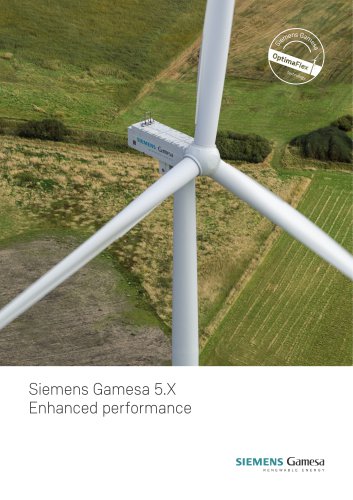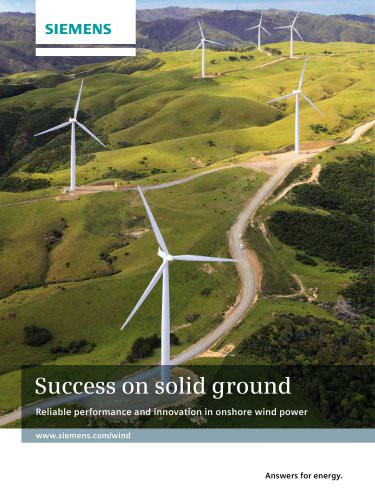
カタログの抜粋

Environmental Product Declaration A clean energy solution – from cradle to grave Offshore wind power plant employing SWT-6.0-154 siemens.com / wind
カタログの1ページ目を開く
Assessing the performance of a wind power plant The environmental impact of wind power The world today faces the challenge of meeting growing demand for energy while reducing greenhouse gas emissions. One solution is to increase the contribution of renewable energy systems such as wind, sun, or biomass to the electricity mix. Siemens Wind Power is pioneering this approach by offering an extensive wind turbine portfolio that includes the SWT-6.0-154 direct drive turbine. Siemens has performed a Life Cycle Assessment (LCA) of an offshore wind power plant employing SWT-6.0-154. The LCA...
カタログの3ページ目を開く
Designed to deliver clean energy Offshore wind power plant Each wind power plant has specific site constraints that influence the choice of turbine, tower height, foundation size, and infrastructure. This EPD is based on a full-scale LCA of an average European offshore wind power plant with 80 SWT-6.0-154 turbines installed. It includes wind turbine components such as a nacelle, rotor, and tower, as well as the foundation, cables to grid, and substation. The functional unit for this LCA is defined as 1 kWh of electricity delivered to the grid. The identified average wind speed is relative...
カタログの4ページ目を開く
System boundaries for an offshore wind power plant Direct drive conversion Nacelle Blades Tower Substation Connecting cables
カタログの5ページ目を開く
From cradle to grave Life cycle of a wind power plant The lifecycle has been divided into five main stages: Materials, Manufacturing of the main parts; Installation; Operation and Maintenance; Dismantling, Recycling, and Disposal at the end-of-life. Relevant transport activities and energy consumption were included in each life cycle stage. Life Cycle Stages tl
カタログの6ページ目を開く
Materials We identified the types and quantities of materials and energy that had to be extracted and consumed to produce the turbine components and the elements needed to connect the wind power plant to the grid. Manufacturing We collected data from Siemens’ own production sites and from main suppliers. Consumption data for manufacturing as well as waste and subsequent treatment is based primarily on annual manufacturing data from European production sites. Transport of materials to the manufacturing site is included in the data. Installation Components, auxiliary resources, and workers...
カタログの7ページ目を開く
Environmental footprint Low greenhouse gas emissions Greenhouse gases such as CO2 and methane contribute to global warming. Electricity produced by wind turbines contributes significantly less to global warming than electricity produced by fossil fuels. During its lifetime, the wind power plant emits less than 1% of the CO2 emitted per kWh by an average power plant using fossil fuels. What is “global warming”? Global warming is an environmental impact caused by the increased concentration of greenhouse gases in the atmosphere. Each of these gases radiates different amounts of heat, which...
カタログの8ページ目を開く
CO2 emissions from the wind power plant versus global fossil power production (IEA World Energy Outlook, 2012) forest area During its estimated lifetime the wind power plant produces 53,000,000 MWh and saves 45,000,000 tonnes of CO2, which is equal to the amount of CO2 absorbed by a forest with an area of 1,286 km2 over 25
カタログの9ページ目を開く
Every stage counts Contributions to global warming To examine how much each stage of the wind power plant’s life cycle contributes to global warming, we assessed their specific CO2 emissions (figure below). Percentage of global warming contribution from each life cycle stage (g CO2 eq/kWh) Operation & Maintenance Dismantling & end-of-life The main contributor to global warming is the Material stage (69%) because of emissions during material extraction. There are almost no emissions during wind power plant operation, and there is even an offset to emissions at end-of-life because so many of...
カタログの10ページ目を開く
Global warming contribution of main components in the wind power plant (CO2 eq) Connecting Cables (14%) Tower (17%) Global warming contribution per material group in the wind power plant (CO2 eq) Other materials (3%) Copper (2%) Fiberglass (3%) Cast Iron (4%) Polyurethane (6%)
カタログの11ページ目を開く
Taking a holistic view Assessing additional impact categories Environmental sustainability also concerns problems other than climate change; for example, chemical pollution and resource depletion. Electricity produced by a wind power plant can be assessed for different environmental impact categories. Such an assessment shows that focusing solely Definitions of most relevant environmental impact categories Global warming: An environmental impact caused by the increased concentration of greenhouse gases in the atmosphere. Mineral extraction: The removal of minerals from the environment,...
カタログの12ページ目を開く
Contribution of each Life Cycle Stage to the most relevant impact categories Global warming (kg CO2 eq) Mineral extraction (MJ surplus) Land occupation (m2org.arable) Ecotoxicity (CTUe) Human toxicity, noncancer (CTUh) Human toxicity, cancer (CTUh) Materials Manufacturing Installation Operation Dismantling & end-of-life Other environmental impacts Planning a new wind power plant includes assessing the environmental impact of the installation and operation phases to minimize negative impacts. Often these assessments focus on birds, marine wildlife and visual impacts. How a wind power plant...
カタログの13ページ目を開く
Recycling turbine materials When wind turbines are dismantled, it is typically not because they have reached end-of-life but because they are replaced with larger turbines. Consequently, most dismantled turbines are refurbished and sold for installation elsewhere. When disposing of wind turbines, recycling is the preferred solution. This not only prevents the materials from being sent to landfills, but also reduces the need for extracting of primary materials. Options for recycling or disposal The metals in the wind power plant components are to a great extent recycled at their end-of-life....
カタログの14ページ目を開くSIEMENS GAMESAのすべてのカタログと技術パンフレット
-
SG 8.0-167 DD
2 ページ
-
SG 11.0-200 DD
3 ページ
-
SG 14-222 DD
3 ページ
-
SWT-DD-130
2 ページ
-
SWT-DD-120
2 ページ
-
Siemens Gamesa 5.X
4 ページ
-
SG 2.9-129
4 ページ
-
SG 5.0-132
4 ページ
-
SG 3.4-132
4 ページ
-
SG 2.6-114
4 ページ
-
SG 2.2-122
4 ページ
-
SG 2.1-114
4 ページ
-
SWT-2.3-120
4 ページ
-
SWT-3.3-130
4 ページ
-
SWT-7.0-154
4 ページ
-
D6 Platform
8 ページ
-
SICAM General
232 ページ
-
integralBlades®
2 ページ
-
Turbine Load Control
2 ページ
-
SWT-6.0
16 ページ
-
SWT-3.0
8 ページ
-
SWT-3.6-120
10 ページ
-
SWT-2.3-113
8 ページ
-
SWT-2.3-108
8 ページ
-
SWT-2.3-101
8 ページ
-
SWT-2.3-93
8 ページ
-
SWT-2.3-82
8 ページ
カタログアーカイブ
-
SWT-3.6-107
8 ページ















































